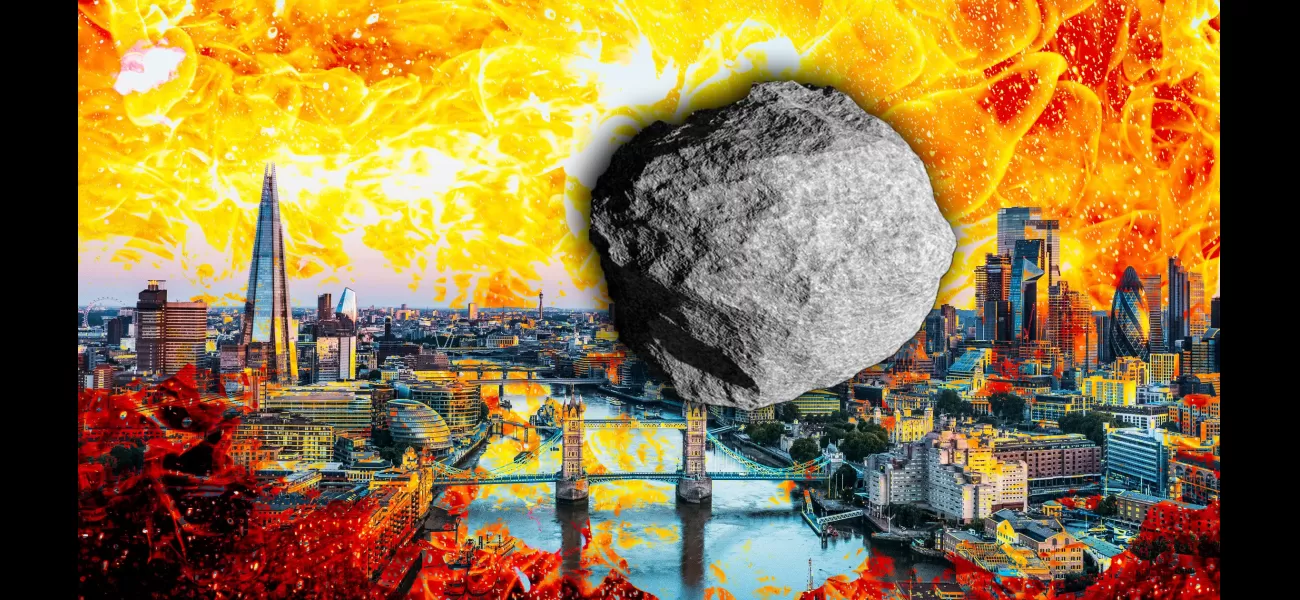If an asteroid bigger than the Eiffel Tower collided with Earth, there would be catastrophic consequences.
European Space Agency is planning a mission to prevent potential catastrophic events from occurring on Earth.
July 28th 2024.

A large asteroid, comparable in size to a cruise liner, is set to pass by Earth in five years' time. This may sound like a plot from a disaster movie, but it is a very real possibility. Named 99942 Apophis after the Egyptian god of chaos and destruction, this asteroid was discovered in 2004 and initially caused concern among scientists due to its potential to collide with Earth. Thankfully, further calculations showed that it would not hit us, but it serves as a reminder of the dangers posed by other asteroids in our solar system.
Despite our continued efforts to track and study asteroids, there is still a lot we don't know about their composition and behavior. This is why a "planetary defense" mission is in the works for when Apophis makes its close approach to Earth on April 13th, 2029. The goal of this mission is to study potential methods for deflecting an asteroid in the event that one does come on a collision course with our planet.
According to astronomer Dr. Greg Brown, if an asteroid of this size were to hit a highly populated area, the damage would be catastrophic. The impact would be equivalent to dozens of nuclear bombs and would result in millions of fatalities. The entire city of London would be vaporized and the surrounding areas would also suffer significant damage. The impact would be so powerful that those near the crash site would not even realize what had happened as they would be immediately killed.
Thankfully, most of the Earth's surface is not densely populated, so the chances of an asteroid causing widespread devastation are relatively low. However, the potential for destruction still exists and it is important for organizations like NASA and the European Space Agency to continue their efforts in studying and tracking these space rocks.
It is worth noting that the impact of an asteroid is directly related to its size. The larger the asteroid, the more damage it can cause. For example, the asteroid that led to the extinction of the dinosaurs was at least 10km wide and caused a global climate change due to the amount of dust it kicked up. Even a smaller asteroid, like Apophis, can still have significant effects on the local environment and economy.
While we have identified and tracked most of the "planet killers" in our vicinity, there is still a concern about mid-size asteroids measuring around 400 meters. The number of these asteroids that we have identified is significantly lower than the number we believe to be out there. This is a cause for concern as these mid-size asteroids could still cause significant damage if they were to hit Earth.
In the grand scheme of things, the chances of an asteroid causing mass extinction on Earth are low. However, the potential for destruction and loss of life is still a very real threat. This is why it is crucial for us to continue our efforts in studying and tracking asteroids, and to be prepared for any potential impact.
Imagine for a moment that a massive asteroid was hurtling towards Earth, on a collision course with a densely populated city like London. The sheer size of the asteroid would result in a catastrophic explosion upon impact, causing widespread devastation and loss of life. The thought of this scenario may seem like a morbid exercise, but it is a very real possibility. In fact, in just five years, a massive asteroid the size of a cruise liner will pass by Earth at a distance closer than TV satellites, in what is being described as a stunning near miss.
This particular asteroid, named 99942 Apophis after the Egyptian god of chaos and destruction, was discovered in 2004 and initially caused a great deal of concern among scientists. There was a fear that it might collide with Earth, and models showed that it could potentially cause catastrophic damage. However, further research revealed that it would fly back out into space, avoiding a collision. But the fact remains that there are other asteroids of this size in our solar system, and we still do not know exactly how many there are or where they may be headed.
This is why a "planetary defense" mission is currently underway to study Apophis when it makes its close approach to Earth on Friday, April 13th, 2029. The goal is to learn more about how we might be able to deflect an asteroid if it were to come on a collision course with our planet. Dr. Greg Brown, an astronomer from the Royal Observatory in Greenwich, explains that if an asteroid of this size were to hit a populated area, the consequences would be catastrophic. He warns that if it were to hit a city like London, it would essentially wipe out most of the population and cause a massive explosion equivalent to dozens of nuclear bombs.
In the event of an asteroid strike, there is very little we can do to protect ourselves. By the time we would see a trail of light in the sky, it would already be too late to take any action. The asteroid would be like a messenger of doom, signaling the impending cosmic explosion that would vaporize everything in its path. And unfortunately, this is not just a hypothetical scenario. Just last month, on June 29th, an asteroid measuring around 150 meters passed by Earth at a distance closer than the Moon. And we only spotted it 13 days before it passed.
One of the main challenges in detecting and tracking potentially hazardous asteroids is that they can be difficult to spot. As Dr. Brown points out, two thirds of Earth's surface is covered in water, and even the majority of land is sparsely populated. So while the chances of an asteroid causing a mass extinction event like the one that wiped out the dinosaurs are small, it is still a possibility that we must take seriously. This is why organizations like NASA and the European Space Agency are working on planetary defense missions to study the composition and behavior of asteroids.
Scientists have identified and tracked all of the "planet killers" in our vicinity, which are asteroids large enough to cause a mass extinction event. And thankfully, none of them are currently on a collision course with Earth. However, there is still a concern about mid-size asteroids, measuring around 400 meters across. The number of known mid-size asteroids is significantly lower than the number that is estimated to exist based on the number of larger and smaller asteroids we have observed. This is a cause for concern, as these mid-size asteroids could still cause significant damage and loss of life if they were to strike Earth.
In the end, the size of an asteroid is directly related to the amount of damage it can cause. Large asteroids have the potential to wipe out humanity, while smaller ones typically burn up in the atmosphere. But even a relatively small asteroid, like the one that passed by Earth last month, can still have a significant impact on our planet. It is a reminder that we must continue to study and monitor potentially hazardous asteroids in order to protect ourselves from the devastating consequences of a collision.
Despite our continued efforts to track and study asteroids, there is still a lot we don't know about their composition and behavior. This is why a "planetary defense" mission is in the works for when Apophis makes its close approach to Earth on April 13th, 2029. The goal of this mission is to study potential methods for deflecting an asteroid in the event that one does come on a collision course with our planet.
According to astronomer Dr. Greg Brown, if an asteroid of this size were to hit a highly populated area, the damage would be catastrophic. The impact would be equivalent to dozens of nuclear bombs and would result in millions of fatalities. The entire city of London would be vaporized and the surrounding areas would also suffer significant damage. The impact would be so powerful that those near the crash site would not even realize what had happened as they would be immediately killed.
Thankfully, most of the Earth's surface is not densely populated, so the chances of an asteroid causing widespread devastation are relatively low. However, the potential for destruction still exists and it is important for organizations like NASA and the European Space Agency to continue their efforts in studying and tracking these space rocks.
It is worth noting that the impact of an asteroid is directly related to its size. The larger the asteroid, the more damage it can cause. For example, the asteroid that led to the extinction of the dinosaurs was at least 10km wide and caused a global climate change due to the amount of dust it kicked up. Even a smaller asteroid, like Apophis, can still have significant effects on the local environment and economy.
While we have identified and tracked most of the "planet killers" in our vicinity, there is still a concern about mid-size asteroids measuring around 400 meters. The number of these asteroids that we have identified is significantly lower than the number we believe to be out there. This is a cause for concern as these mid-size asteroids could still cause significant damage if they were to hit Earth.
In the grand scheme of things, the chances of an asteroid causing mass extinction on Earth are low. However, the potential for destruction and loss of life is still a very real threat. This is why it is crucial for us to continue our efforts in studying and tracking asteroids, and to be prepared for any potential impact.
Imagine for a moment that a massive asteroid was hurtling towards Earth, on a collision course with a densely populated city like London. The sheer size of the asteroid would result in a catastrophic explosion upon impact, causing widespread devastation and loss of life. The thought of this scenario may seem like a morbid exercise, but it is a very real possibility. In fact, in just five years, a massive asteroid the size of a cruise liner will pass by Earth at a distance closer than TV satellites, in what is being described as a stunning near miss.
This particular asteroid, named 99942 Apophis after the Egyptian god of chaos and destruction, was discovered in 2004 and initially caused a great deal of concern among scientists. There was a fear that it might collide with Earth, and models showed that it could potentially cause catastrophic damage. However, further research revealed that it would fly back out into space, avoiding a collision. But the fact remains that there are other asteroids of this size in our solar system, and we still do not know exactly how many there are or where they may be headed.
This is why a "planetary defense" mission is currently underway to study Apophis when it makes its close approach to Earth on Friday, April 13th, 2029. The goal is to learn more about how we might be able to deflect an asteroid if it were to come on a collision course with our planet. Dr. Greg Brown, an astronomer from the Royal Observatory in Greenwich, explains that if an asteroid of this size were to hit a populated area, the consequences would be catastrophic. He warns that if it were to hit a city like London, it would essentially wipe out most of the population and cause a massive explosion equivalent to dozens of nuclear bombs.
In the event of an asteroid strike, there is very little we can do to protect ourselves. By the time we would see a trail of light in the sky, it would already be too late to take any action. The asteroid would be like a messenger of doom, signaling the impending cosmic explosion that would vaporize everything in its path. And unfortunately, this is not just a hypothetical scenario. Just last month, on June 29th, an asteroid measuring around 150 meters passed by Earth at a distance closer than the Moon. And we only spotted it 13 days before it passed.
One of the main challenges in detecting and tracking potentially hazardous asteroids is that they can be difficult to spot. As Dr. Brown points out, two thirds of Earth's surface is covered in water, and even the majority of land is sparsely populated. So while the chances of an asteroid causing a mass extinction event like the one that wiped out the dinosaurs are small, it is still a possibility that we must take seriously. This is why organizations like NASA and the European Space Agency are working on planetary defense missions to study the composition and behavior of asteroids.
Scientists have identified and tracked all of the "planet killers" in our vicinity, which are asteroids large enough to cause a mass extinction event. And thankfully, none of them are currently on a collision course with Earth. However, there is still a concern about mid-size asteroids, measuring around 400 meters across. The number of known mid-size asteroids is significantly lower than the number that is estimated to exist based on the number of larger and smaller asteroids we have observed. This is a cause for concern, as these mid-size asteroids could still cause significant damage and loss of life if they were to strike Earth.
In the end, the size of an asteroid is directly related to the amount of damage it can cause. Large asteroids have the potential to wipe out humanity, while smaller ones typically burn up in the atmosphere. But even a relatively small asteroid, like the one that passed by Earth last month, can still have a significant impact on our planet. It is a reminder that we must continue to study and monitor potentially hazardous asteroids in order to protect ourselves from the devastating consequences of a collision.
[This article has been trending online recently and has been generated with AI. Your feed is customized.]
[Generative AI is experimental.]
0
0
Submit Comment





